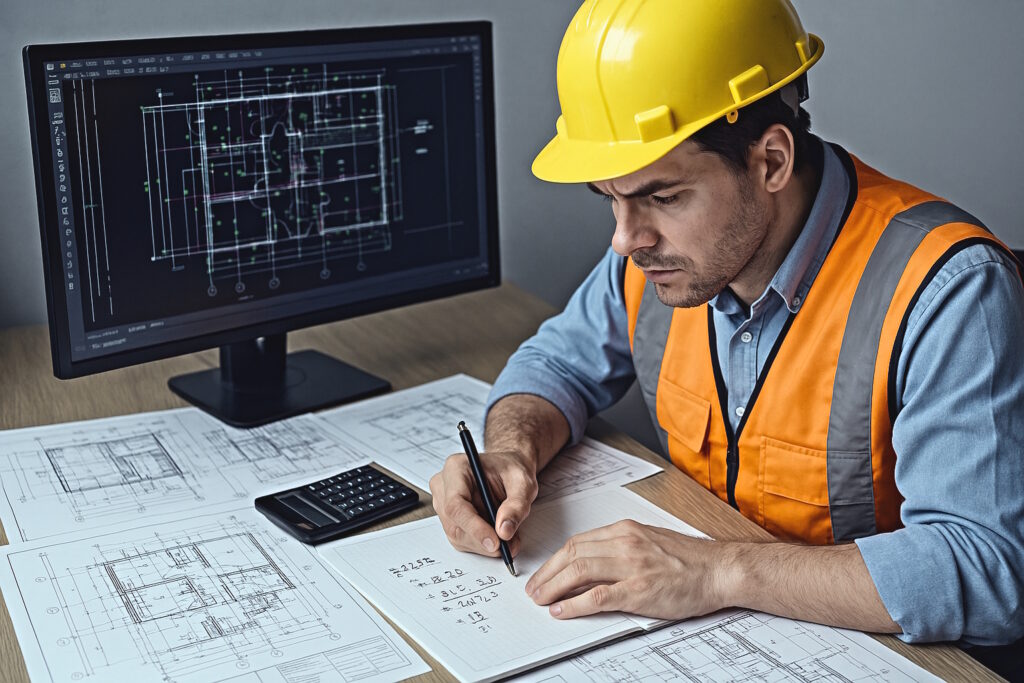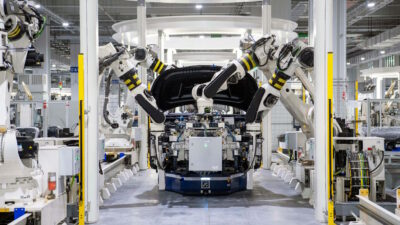Introduction
Where innovation meets precision, choosing the right structural engineering companies for your industrial building project is both an art and a science. Industrial buildings need more than a solid framework; they need engineering partners who can marry advanced structural engineering with comprehensive detailing and digital integration.
Industrial buildings—factories, warehouses, power plants—require engineering solutions that address heavy machinery loads, seismic resilience and energy efficiency. Unlike commercial or residential structures, these facilities need to integrate specialized systems like overhead cranes, insulated overhead doors and hazardous material storage while maintaining structural integrity. For example, a cold storage facility needs to balance thermal insulation with load bearing capacity, while a manufacturing plant needs vibration resistant foundations to support heavy equipment.
This article will discuss the key factors to consider when selecting firms that specialize in industrial building structural design. We will cover everything from steel detailing and precast detailing to BIM services, shop drawing and CAD service. Our aim is to help decision makers in industrial construction choose professionals who can deliver better project outcomes while ensuring structural integrity and optimizing project efficiency.
Industrial Building Construction Needs
Industrial buildings are more than large warehouse spaces; they are complex infrastructures for raw material storage, light manufacturing buildings, power plants, research and development centers and even cold storage facilities. When evaluating industrial building construction projects consider the following:
- Purpose & Functionality: Every industrial building is unique. Whether it’s for industrial facilities that house heavy machinery or industrial spaces for distribution centers and office space, understanding the intended function is key.
- Load Requirements & Structural Integrity: The construction process must account for heavy loads, dynamic forces and environmental impacts. Structural engineering companies ensure the industrial building’s load bearing capacity is rigorously calculated.
- Use of Construction Materials: Industrial buildings use a mix of construction materials—from steel and reinforced concrete to advanced composites—to create a solid foundation and efficient building systems.
- Efficient Construction Process: The construction process for an industrial building should integrate latest construction techniques, precast detailing and storing raw materials for later use. This integration minimizes delays and improves project outcomes.
- Sustainable Practices: Today’s industrial building construction projects focus on sustainable building design. This includes energy efficiency measures and water conservation measures to reduce overall environmental impact. In industrial building construction every detail matters. For example in a recent industrial project in Houston a major structural engineering company successfully integrated precast elements and insulated overhead doors to improve energy efficiency and project efficiency.
Structural Engineering in Industrial Buildings
Structural engineering is at the heart of industrial building construction. Structural engineers design and verify that the building systems will support everything from industrial facilities to flex buildings and distribution centers. They consider every structural element—from steel beams to rebar detailing—to ensure the building’s overall stability and safety.
- Structural Engineering in Industrial Buildings: Structural engineering is critical to ensure the industrial building can support heavy equipment and high load bearing requirements. The process involves extensive calculations and simulations to assess structural components and building systems.
- Structural Engineers at Work: Structural engineers create designs that not only support the industrial building but also integrate with electrical systems, transportation infrastructure and office space within the project. Their work must meet the strict standards set by Eurocodes and ASCE guidelines.
- Industrial Construction and Structural Integrity: In industrial building construction the construction process demands a holistic approach to ensure every element, including insulated overhead doors and fewer materials in some sections, works together for optimal building performance. Structural engineers ensure the building’s structural design meets these complex criteria.

Core Elements of Structural Engineering for Industrial Buildings
Design Process and Load Analysis
Structural engineering for industrial buildings starts with a rigorous design process. Structural engineers work with architects and civil engineers to create a blueprint that meets the demands of heavy equipment, industrial facilities and dynamic loads. This involves:
- Conceptual Design: Translating functional needs into a feasible structural system.
- Load Analysis: Evaluating dead loads, live loads and environmental loads (e.g. wind and seismic forces) to ensure the building’s load bearing capacity is sufficient.
- Iterative Structural Analysis: Using advanced structural software such as ETABS and SAP2000 to simulate and optimize structural components.
- System Design: Finalizing the arrangement of beams, columns and connections to deliver a robust building system.
Material and Detailing Services
The success of an industrial building relies on detailed planning at material level. This includes:
Steel Detailing
Steel detailing involves preparing detailed drawings for steel fabrication and erection. In industrial building construction these drawings are critical to ensure the steel framework—integral to industrial building stability—is fabricated accurately.
Key aspects:
- Connection details including welds and bolts
- Steel components for industrial facilities
- Coordination with other structural components for industrial building construction
For expert steel detailing services, explore offerings by trusted vendors on BuildTwin.
Precast Detailing
Precast detailing allows for offsite production of concrete elements used in industrial buildings. This ensures quality control and reduces onsite construction time. Highlights:
- Precast panels, beams and columns detailed for installation
- Connection details for rapid assembly
- Reduced construction costs through efficient processes Example: Many industrial building construction projects use precast detailing for large warehouse spaces and cold storage facilities.
Learn more about specialized precast detailing services here.
Rebar Detailing
Rebar detailing is critical in reinforced concrete elements and ensures the reinforcement layout meets structural design specifications. Important points:
- Rebar layouts
- Coordination with precast and steel detailing for overall structural integrity
- Load bearing capacity for heavy industrial construction Example: Rebar detailing by leading structural engineering companies supports concrete floor systems in industrial buildings for light manufacturing. Explore rebar detailing services provided by expert vendors.
BIM, Shop Drawing, Revit BIM & Drafting Services
Digital documentation has transformed industrial construction with BIM (Building Information Modeling) and Revit BIM services. Benefits:
- 3D models that integrate structural components, building systems and construction materials
- Coordination among project stakeholders and civil engineers
- Shop drawings that serve as the blueprint for onsite construction
For a closer look at digital integration, explore BIM services offered by expert vendors on BuildTwin Marketplace, see here.
Structural Software and CAD Services
Advanced software solutions like AutoCAD, Tekla Structures and specialized structural analysis tools are key to modern industrial building construction. Advantages:
- 2D and 3D drafting for industrial building design
- Simulation of building systems to verify structural integrity
- Integration with BIM workflows for documentation
Each of these services is critical to ensure the final industrial building construction is error free.
Digital Integration and Documentation Services
Digital technology is at the heart of modern industrial building construction. BIM and advanced CAD solutions ensure every detail is mapped out accurately.
BIM and Revit BIM Services
- Building Information Modeling (BIM): This digital process allows for creation of a 3D model that integrates structural, MEP (mechanical, electrical, and plumbing), and architectural systems. For industrial facilities, BIM improves coordination among project stakeholders and reduces clashes. In fact, a study showed that BIM implementation in industrial construction improves project efficiency by 25%.
- Revit BIM Service: Revit offers precise modeling and is widely used by structural engineering companies. It helps in generating shop drawings and enables communication between structural engineers and fabricators.
For cutting-edge BIM solutions, check out: BIM Services
Shop Drawings, CAD Services and Structural Software
- Shop Drawings: These are the final construction documents after design approval. They include detailed drawings for steel, precast and rebar components. Proper shop drawings ensure contractors can execute the design with minimal deviations.
- CAD Services: Computer-Aided Design (CAD) is used to create 2D drawings from 3D models. Civil engineers and structural engineers use CAD tools to produce fabrication and installation drawings that meet industry standards. Explore precision CAD design and drafting services.
- Structural Software: Tools like Tekla Structures, ETABS and SAP2000 are used to simulate structural behavior and ensure compliance to safety standards. For example, in a complex infrastructure project in New York, Tekla Structures was used to detect potential issues early, saving significant time and construction costs.

How to Choose the Best Structural Engineering Vendor for Industrial Buildings
When selecting the right partner for your industrial building construction consider the following:
- Expertise in Industrial Buildings:
Ensure the firm has experience in industrial building construction and has worked on projects from industrial facilities to flex buildings and distribution centers. - Comprehensive Service Offering:
Top structural engineering companies offer services including steel detailing, precast detailing, rebar detailing, BIM services and CAD services that cover the entire construction process. - Proven Track Record:
Look for firms with a history of successful industrial projects. Check project outcomes and case studies for industrial buildings, light manufacturing buildings and cold storage facilities. - Innovative Solutions:
Companies that integrate technology like generative AI with BIM or holistic optimization techniques are more likely to improve project efficiency and energy efficiency. - Compliance to Codes and Standards:
The firm should follow international standards like Eurocodes and ASCE guidelines. This ensures every industrial building design meets the highest structural engineering standards. - Project Management and Communication:
Good project management is key. Top firms should provide transparent communication and robust project management for timely and cost effective delivery. - Sustainability:
With the focus on sustainable building design, the ideal firm will incorporate green practices and sustainable infrastructure.
View portfolio of completed projects and detailed work by expert vendors: Explore Structural Engineering Projects.
💡 Key Points at a glance:
- Verify Experience: Ensure the firm has experience in industrial building construction and has delivered industrial projects, from light manufacturing buildings to flex buildings and industrial spaces.
- Review Digital Capabilities: Check the firm uses BIM, Revit BIM services, Digital Twins and structural software to produce shop drawings and CAD services.
- Assess Sustainability Initiatives: Look for firms that prioritize sustainable building design and green construction. Check for LEED or BREEAM certifications.
- Examine Case Studies: Review project portfolio and client testimonials to validate the firm’s project outcomes.
- Check Certifications: Look for ISO 9001 (quality management) and ISO 14001 (environmental compliance).
Top 10 Structural Engineering Firms for Industrial Buildings (2025)
Companies should look for firms with experience in specialized services like structural design, steel detailing, precast detailing, rebar detailing and advanced BIM integration. Here’s a closer look:
J&F
Operating in India, USA, EU, Middle East, UK, Germany and Australia, J&F India offers structural design, precast detailing, BIM modeling and BoQ/QS services. Their portfolio includes 400+ projects—from airport terminals to high-rise renovations
👉 J&F
Mold-Tek Technologies Limited
Specializing in structural steel detailing and precast detailing, Mold-Tek serves chemical plants, theatres, manufacturing plants and more. Their expertise has supported projects like MOLSON Coors facilities and mission-critical structures across USA, ensuring precision and efficiency in every detail.
👉 Mold-Tek Technologies Limited
GBC Engineers
Vietnam and Germany based GBC Engineers excels in PEB design and detailing, BIM modeling and project management. Their work on TESLA Gigafactory in Berlin-Brandenburg and infrastructure developments showcases their capability to manage complex industrial projects.
Aarbee Structures Private Limited
Industrial detailing focused Aarbee Structures provides high quality steel and precast detailing services for stadiums, transportation hubs and large commercial buildings across USA and India.
👉 Aarbee Structures Private Limited
Oriole Design Tech Solutions LLP
Offering structural design, digital planning, 3D modeling and shop drawing services Oriole Design Tech Solutions LLP has a diverse portfolio of industrial, commercial and residential projects in USA and India.
👉 Oriole Design Tech Solutions LLP
Arup
Founded in 1946 Arup is a global firm offering engineering, design, planning and consulting services. With presence in 37 countries Arup has worked on numerous industrial projects worldwide emphasizing innovative and sustainable solutions.
👉 Arup
Degenkolb Engineers
Established in 1940 and headquartered in San Francisco Degenkolb Engineers specializes in structural design and has a strong focus on safety and technical excellence. Their portfolio includes various industrial facilities across California.
WSP
With focus on sustainability and integrated project delivery WSP is a leader in managing large industrial projects and infrastructure.
👉 WSP
HDR
HDR’s expertise in advanced infrastructure design and comprehensive project management has made it a go-to firm for critical industrial developments.
👉 HDR
Jacobs
Offering end to end project lifecycle services Jacobs leverages cutting edge technology and deep industry expertise to deliver resilient and efficient industrial structures.
👉 Jacobs
Conclusion
Selecting the top structural engineering companies for industrial building construction is a decision that can make or break an industrial project. With industrial buildings requiring robust design, detailed services and digital documentation, partnering with firms that excel in structural engineering is key.
Why BuildTwin is the Go-To Marketplace for Industrial Building Projects:
For industrial building developers, BuildTwin offers unparalleled advantages:
✅ Access to a global pool of top engineering firms.
✅ AI-driven quality control & automated project tracking.
✅ Effortless bid & vendor management via a fully integrated ERP system.



